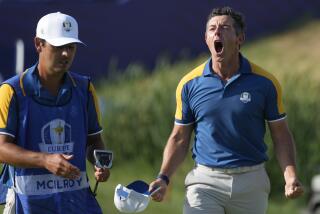Ryder Cup Course Has ‘Made in America’ Tag
- Share via
STRAFFAN, Ireland — Here in the serene, rolling greenness of a former dairy farm, could something be amiss?
Starting Friday, the Ryder Cup will be played nearby, at the Kildare Club, or K Club -- a course designed by Arnold Palmer, one of the legendary figures in American golf and a former U.S. Ryder Cup captain.
Talk about a home-field advantage ... for the visiting team.
It’s the first time a former Ryder Cup captain has designed a layout that the opposing team -- in this case, the defending champion Europeans -- is using as its home course.
Even Palmer was intrigued.
“I hadn’t even thought about it before,” he said, “but that is what I’d call interesting.”
Thus, the 36th Ryder Cup will be played on a U.S.-style parklands course that could have been cut out of someplace in Colorado and dropped into its Irish home about half an hour or so from Dublin.
In this country, renowned for such distinctive and historic venues as Portmarnock, Ballybunion, Lahinch and Portrush, the Ryder Cup spotlight this week is on a course that couldn’t be much newer or any more American unless they’d finished it yesterday and painted the greens red, white and blue.
The Palmer design team began work on the K Club in 1989, after agreeing to a deal with Irish businessman Michael Smurfit, who had bought the property the year before. The K Club opened in 1991 with the Smurfit Course and the Palmer Course. The Ryder Cup will be played, fittingly enough, on the Palmer Course.
When Spanish businessman Jaime Ortiz Patino paid a site fee to the European Tour to hold the 1997 Ryder Cup at his Valderrama layout at Sotogrande, Spain, it opened the door for Smurfit. He paid a fee of at least $750,000 and possibly more than $1 million to the European Tour to get the Ryder Cup for his K Club.
Smurfit, who has a five-star hotel on his property, also persuaded the European Tour to hold its European Open -- the Smurfit European Open -- at the K Club.
As American as the course looks and plays, though, Palmer says there’s no advantage for the U.S. team.
“I think that certainly is a factor, but I don’t think that is going to be a major factor,” he said. “And the fact that the European Open is played on this golf course is probably as much of a factor as anything.
“The European guys are going to know the golf course much better than our guys, even though they went over and practiced.
“And one other major factor, they have played it under all weather conditions, so if there’s an advantage toward the fact that it might be a little, let’s say, favored to the Americans because it’s an American-style golf course, I don’t think that’s a factor at all. I think it comes out pretty even.”
The U.S. team took a charter jet here last month for a couple of days of practice, but, even so, Tiger Woods is no stranger to the K Club. It’s usually on his practice schedule before he plays the British Open.
Ben Crenshaw, the 1999 U.S. Ryder Cup captain, said familiarity with the K Club course could only help: “There’s nothing like laying eyes on the place before the matches.”
The River Liffey meanders through the property and the course seems innocent enough, but appearances might be deceiving.
The 7,335-yard course has four par-three holes, two on each side, but they’re not the main attractions.
There are five par-fives, the shortest the 537-yard 18th that’s all kinds of trouble, with three bunkers down the right, and water to the left and in front of a sloping green that’s guarded by bunkers on the right.
The hole is called “the Hooker’s Graveyard,” so at least you know where you can’t hit it, which is anywhere except the fairway.
Palmer played on six Ryder Cup teams and none of them lost. In 32 matches, third to Billy Casper’s 37 and Lanny Wadkins’ 34, Palmer was 22-8-2, a U.S. record for victories.
Palmer, who turned 77 earlier this month, will make sure he doesn’t miss what happens on the course he designed with partner Ed Seay. He is on hand to see for himself whether there’s a home-course advantage in Ireland for U.S. players, or if a Palmer-designed course translates into Gaelic.
“I think the golf course will hold up and do its thing in these matches,” he said.
“I don’t think there’s any question about how the golf course will fare.”
*
More to Read
Go beyond the scoreboard
Get the latest on L.A.'s teams in the daily Sports Report newsletter.
You may occasionally receive promotional content from the Los Angeles Times.










